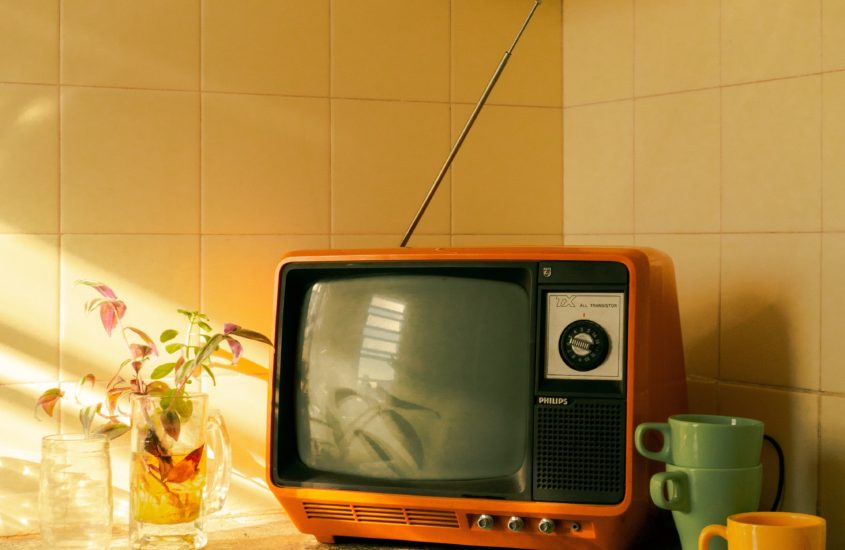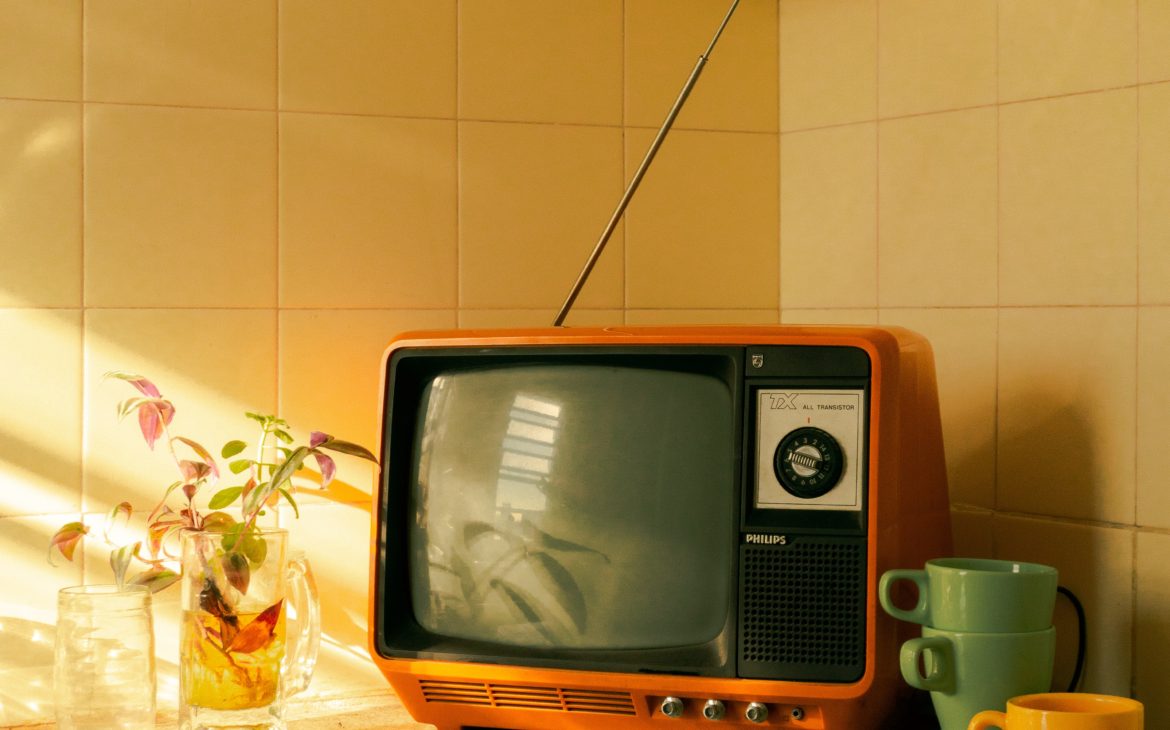How Watching Novelas Get Me Through Tough Times By: Connie Pertuz Meza


The weekend that New York City public schools ended this past June, I escaped with the family to the Jersey Shore, and like the steady lull of the ocean during the day, late at night, I found solace in Colombian novelas on Netflix. This was not my first time devouring novelas like my favorite charcuterie board; think gouda cheese, fig spread, and an olive assortment. My relationship with the dramatic serials began at four, before I ever stepped foot in school, a pobre’s version of nursery school. I’d come to understand that in the midst of a global pandemic, civil unrest, and climate change, longing for what’s familiar is not only natural but necessary for survival.
Some of my early memories are centered around sitting on the edge of my parent’s bed, while Mami worked her way through a pile of Papi’s dress shirts, her hand gripped around an iron, and a board set up in front of her. Once pressed, the shirt was handed off to me to button and last to Joann who would fold it into a neat rectangle. We were an assembly, the three of us, Mami, Joann, and I. I loved that I was able to perform a task before Joann, who at two and a half years my senior, got to do just about everything before me.
“Soledad“, the Mexican telenovela starring Libertad Lamarque, played on the small television resting on the dresser; it gave our minds something to do other than to think about the task at hand or Papi’s absence. A simple housekeeper raising the five children of her dying boss was filled with enough tension to keep me entertained, yet there was something familiar to this premise. While Papi was not dying, and it was only Joann and I, like a magnet I was drawn to this story of dysfunction, where a family was not what it appeared to be, and secrets infected every member. Soledad agreed to the hasty marriage and to mother his five children, not out of deep compassion, but more of a profound sense of debt since one of them was her illegitimate child from a previous relationship. Glued to the television, alongside Mami and my sister Joann, I rooted for Soledad who was cherished by three of the five, and hated by two, one being her biological son.
“Why are they so mean to Soledad?” I would turn to Mami during commercials.
“Son hijueputas,” Mami muttered as a thin veil of steam rose from the tiny spout on the iron.
Mami called people hijueputas or malparidos any chance she could, therefore, I wasn’t surprised how she referred to these characters on television no different than our upstairs neighbor, Papi’s drinking buddies, and Papi himself. Instead, I was left to figure out why horrible things happen to good people on my own, with telenovelas serving as a blueprint on how the world works. Once “Soledad” ended, I felt the weighted vest of crushing sadness. Later in life, I would describe this caving pain to my therapist as an elephant’s foot using my chest as a stool to stand on. My television friends were gone and I was left feeling empty, unaware that their company kept the loneliness of my childhood at bay.
I soon discovered that novelas were like Mami’s rants, just when one finished, another started. And “Soledad” was followed by the Mexican “Encadenados,” about a young woman who falls in love with the boy she was raised with, then the Venezuelan “Topacio” with a blind protagonist who is kidnapped by a disfigured man, and the Mexican “Rosa Salvaje” with tomboy Veronica Castro. Somewhere in sixth grade, I was teased into watching American novelas, which I was told were called soaps and did not finish at all, airing for decades, giving me something to talk about during recess. I soon tested out “Santa Barbara”, “Loving”, “General Hospital”, “One Life to Live“, and “All My Children”. Yet I still found myself drawn to novelas like “Quinceañera”, “Dulce Desafío”, and “Alcanzar Una Estrella” all centered around teen angst. I envied the protagonists for their straight light hair, how boys seemed to fall in love with them at first sight, and how everyone had a cool best friend, and how despite being Latinas themselves, they were not on welfare or lived in the hood. Later, much later, I’d understand how my attachment to these novelas was my attempt to search for identity, to cast my search wider than Rosie Perez, one of the few mainstream Latina representations I grew up with as a child of the eighties and a teen of the nineties.
Once in my twenties, I gave up soaps and novelas altogether, opting to watch reality shows like “Real World”, “The Challenge”, “Teen Mom”, and “Keeping Up with The Kardashians”. Somehow, as an educator, a mother of two, and a wife, these reality shows made me forget my everyday stresses. It would be decades before I watched my next novela, and as far as the gringo soaps were concerned, I quit cold turkey, the summer I left for Colombia after graduating from Hunter College.
I didn’t turn to novelas again till the end of 2017. This was also the year I wrote 52 essays in one year, a writing challenge posed by my teacher on everything personal essay, Vanessa Martir, who invited writers to join her. Inspired by Vanessa’s journey of the personal essay the previous year, I agreed to write a personal essay a week, post it on WordPress, and share it on social media. I promised myself to continue to work on my novel and to still submit other essays and short stories. At the end of the year, I wrote close to 350 pages altogether. I wrote the first few essays similar to how I slip into a pool in the summer, a bit at a time, refusing to submerge and expose myself. With every essay I wrote, I told others I was a writer, also telling myself, but I was unaware of how this shook memories and emotions long buried inside of me, and while not everything made it on the page, memories tumbled in my mind and feelings flooded my body. Yet, with every essay, I dug and often wept over my keyboard, and long after my laptop was closed, my mind refused to shut down. Sleep evaded me, my stomach ran sour, my shoulders ached, and my heart banged around in my chest at a terrifying tempo.
Desperate to turn my mind off, I scanned Netflix late at night and ran across “Surviving Escobar: Alias JJ,” and devoured the sixty-plus episode series, while learning about the tangled web between narcos, guerilla, paramilitaries, polica nacional, and el ejército. Once that novela ended, I hated the sadness which soaked my bones, as if what had occurred was not the final episode of a series, but the loss of something far greater. Disgusted by this pitiful invasion of emotion, I searched for another novela to replace the loss I felt, ignoring this gnawing in the pit of my stomach, never considering how this attachment to the characters of my novelas was due to the unhealthy attachments formed in my formative years. “Lady, La Vendedora De Rosas,” was suggested viewing on my Netflix account, and I soon found myself lost in the world of poverty in Medellin, Colombia, and one heroine’s epic journey.
It went on like this for some time. I taught during the day, wrote at night, and watched Colombian novelas later, all while mothering my children, being a wife, and a daughter to two aging parents. Sleeping very little, I guzzled coffee throughout the day, promising myself to slow down once I reached essay fifty-two, ignoring the constant colds, relentless acid reflux, extreme exhaustion, anxiety, and night terrors, which left me worried I was losing my mind. Then essay fifty-two was written and posted on my blog site and the relief I was sure I’d find did not happen, I searched for another novela, stumbling upon “La Niña”. Thrilled by the eighty-plus episodes it promised, I settled in late at night to watch the story of a young girl kidnapped by la guerilla to be a child soldier, her courageous escape, and her return back into society.
Unable to express myself in a weekly personal essay, my emotions turned on me, feeling held hostage by anxiety, sleep was nearly impossible, and every waking moment was spent ignoring the dread coiled in my stomach. Desperate, I sought the help of a therapist. Sitting across from who would become my therapist, I spoke about wanting to get my feelings back inside me, neatly, and very much like the dresser drawers in my home, articles of clothing neatly stacked and categorized. I also made sure to tell her I didn’t like feelings and that I didn’t like crying, also I was positive my death was imminent. When asked what I meant by this, I explained I was dying from a serious illness in my stomach, I suspected cancer. My therapist insisted on how we would work together to put me back together, but I would not be like those drawers, but like a Japanese urn, who when shattered got put back together with gold. I left her office with a tiny bit of hope and an overwhelming need to weep.
It would be exactly two years from our first appointment to the start of the global pandemic. No longer certain I was dying, able to cry now, skilled at scanning my body, daily meditation, and stronger yoga practice, all with a handful of essays published. I was healing. Then the world went upside down. Words like COVID-19, apex, social distancing, and infection rate quickly became part of my lexicon. New York City was an epicenter, schools were closed, both my parents became sick, and everything seemed dangerous. I signed a DNR/DNI, to keep the EMT workers from carting my Papi to the local hospital, which was under a tent. In a mask, plastic gloves, and keeping more than six feet apart, I visited my parents daily, going to the supermarket and picking up their medicines. I watched my father sip on Pedialyte and burn with fever for over two weeks. My mother slept all day, ate little, and coughed every few seconds. My son learned from my bedroom, and my daughter learned from their room, I taught from my living room. My mother-in-law moved with us, my father-in-law was sick too, infected in the at the nursing home we placed him in late December. My husband watched endless hours of the news and I prayed to the ancestors to help me put one foot in front of the other.
Then Geroge Floyd was murdered. Civil unrest spilled into the streets in all the major cities, nonstop coverage of protests took over the airwaves, and curfews were put in place, and the world seemed to take another tilt. I braced myself, as I searched for the ground beneath.
After having had my fair share of trauma, I’m still surprised how it creeps up on me later, once the said trauma has passed, leaving me reeling. It was at the Jersey Shore late at night, the sound of the ocean waves crashing, the smell of salt air, and the silence of a summer night, that I wept for what had happened and what would happen. Needing to escape this topsy turvy world I found myself, and we still are in, I looked for something familiar, like the grilled cheese sandwiches Mami made when I would come home for lunch, comfort—-novelas.
That very night I sat with my kids to watch the first episode of “Amar y Vivir“. A love story of a former soldier whose family land is taken by the town narco and ends up moving to Bogota, where he meets a young woman who dreams to sing ballads and will stop at nothing to chase her dream. As I neared the end of the novela, I searched for another to have ready on deck, I now watched the characters and their world with envy, the word COVID-19 was not in their consciousness, and their innocence to the global pandemic unfolding in my life stirred a longing inside. I turned to “Los Briceño” in August, a family of truck drivers from a small town on the outskirts of Bogota lets me escape the educational debate that gripped our nation, while the opening of New York City public schools loomed over my head. September would mark my twentieth year of teaching and what was to be a milestone in my professional career, now stained by the politicization of the schools opening in the Fall.
I’m now watching “La Vengeza De Analia”, the main character is a political strategist who is bent on destroying the man running to be the president of Colombia, who raped her mother and denied her. I’m not sure what I will be watching after Analia is done with her vengeance, but I’m sure as I get close to the final episode I will begin a search. I’m working from home and New York City schools resemble a stalling car, despite how much the politicians will it to run smoothly.
I might not be your typical novela watcher, I read the New York Times with the scrutiny of a woman who doesn’t want to be caught off guard again. I listen to podcasts on education, juggle reading books on history, psychology, education, critical race theory, memoirs, and fiction, and listen to the latest self-help book on Audible. Yet, I’m proud to say I watch novelas, they help deepen my understanding of the structure and character development, along with many attended workshops and a plethora of books on craft. What I didn’t realize until this summer was how novelas have kept me company during lonesome periods of my life. When set in Colombia, novelas have taught me about my parent’s country, the latest slang, landscape, history, and the resilience of people. Novelas serve as a reminder, how good does win, how hope prevails, moments of joy can still be found despite the eruption of chaos.



